
Has your pup had some strange health issues lately that just can’t be explained? Unfortunately, there’s a very real chance that your dog may have worms. It’s actually the most common health issue in dogs. As dog owners, the thought that our pup may have worms is truly terrifying – after all, nobody wants to think of these tiny, disgusting, slimy creatures poking around our beloved pet’s insides. Unfortunately, they can make themselves known in different ways resulting in several possible signs and symptoms. Although these signs and symptoms may not apply only to a worm infestation, if your pup is exhibiting or more of them, whether or not they have worms is certainly something to consider. We’re going to take a look at all the possible signs and symptoms of a worm infestation so you can know what you’re dealing with and get them help as soon as possible.
Contents
What are worms in dogs and what type could my dog have?
When we think of worms, we think of what we find out in our back garden – long, slimy, wriggly little creatures that like to roll around in our soil. But there are many different types of worms and these are certainly not the type that may be making your pup sick. When it comes to worms in dogs, they are a type of parasite that generally like to attach themselves to your pup’s intestines. There are six different types of worms found most commonly in dogs. They include:
Roundworm
Most puppies are born with microscopic roundworm larvae buried in their tissues which are transmitted to the pup from their mother. If the mother has roundworm and it’s not managed during pregnancy, the odds are it will be transmitted through the mother’s milk after birth.
Once the larvae make their way to the intestinal tract, they can grow up to a whopping five inches in length. At this point, they start shedding eggs, settling themselves even deeper into your poor puppy’s small intestine. Inevitably, your pup starts passing worms in its stool which can infect any other dog, cat, or animal that ingests the stool or the grass that came in contact with the stool.
Because roundworm is practically unavoidable, puppies are dewormed multiple times from birth, both as a treatment and a preventative measure. Why not just deworm the mother to prevent this possible transmission of larvae? Unfortunately, deworming the mother does not get rid of the encysted larvae in the body tissues and cannot prevent the larvae from infecting the newborn pups.
Whipworm

Unlike roundworm, whipworm is not transmitted in utero or through nursing after birth. In fact, a dog doesn’t need to have any direct contact with another pup at all to contract whipworm. For a dog to get it, whipworm eggs need to be digested. This can occur not only through stool but also through infected soil or grass. Once whipworm eggs have been deposited into the environment by infected dogs, foxes, coyotes, and other wild animals, they can live for years. Therefore, whipworms can pose a significant risk to your pup and can be easily contracted when it is exploring outdoors.
Whipworms live in the large intestine and are difficult to diagnose because, unlike roundworm, whipworms do not shed many eggs. Even several stool samples may not prove the existence of whipworms. They are generally diagnosed based on the presence of certain symptoms.
Hookworm
Hookworms are small, thin, blood-sucking parasites that attach themselves to the small intestine. Similarly to roundworms, hookworms can be transmitted either in utero, by contact with larvae in contaminated stool or soil, or by ingesting the eggs through their mother’s milk after birth. Unfortunately, a chronic hookworm infestation is much more dangerous than roundworms and can even cause death in young puppies because hookworms are depleting their blood supply, which can quickly make them severely anemic.
Lungworm
Lungworm is another parasitic worm that affects both dogs and foxes and can be contracted by eating the lungworm larvae found in infected snails, slugs, or frogs. Your pup can still get infected if they don’t eat one of these slimy creatures – tiny slugs may be crawling on one of their toys or in their fur. The lungworm larvae grow inside the dog where the adult begins to move throughout its body, making its way to the heart and blood vessels.
Surprisingly, lungworm is one of the only types of parasitic worm that cannot be passed directly from dog to dog – lungworm needs their slimy snail or frog hosts to grow and develop.
Lungworm can cause truly alarming symptoms such as hemorrhages in the lungs, liver, intestine, eyes, and spinal cord, and can be fatal if left untreated. It is quite difficult to treat – lungworm can be a chronic disease, lasting months or even years.
Tapeworm
Tapeworm is transmitted to dogs that have ingested fleas as the result of fleas’ affinity for eating tapeworm eggs. They may also be transmitted to dogs who like to hunt wildlife or rodents that are infested with tapeworm or fleas.
If you’re familiar with tapeworms, you know that they can grow quite large inside the body – usually four to six inches in length – with as many as 90 segments per tapeworm.
Tapeworm is usually easy to diagnose as it can be visibly seen attached to the fur around the anus or under the tail. Unfortunately, they are not easily killed.
Heartworm

Heartworm is spread to dogs through mosquito bites and is incredibly dangerous. A heartworm can be up to fourteen inches long and buries itself inside the heart and arteries. Because of its presence and size, a heartworm can cause death in dogs if untreated. This is why, especially in certain states and different parts of the world, it is recommended that dogs be on monthly heartworm medications as a preventative measure.
Can worms be dangerous to humans?
The unfortunate answer to this question is yes. In fact, the most common dog worm, Toxocara canis, can be passed on to humans and children are by far the most susceptible to it. A healthy adult’s immune system should be able to deal with the threat of this common worm but if by some chance a child was to ingest worm eggs, they can become infected. The worm larvae move throughout the child’s tissues which can end up being a serious cause for concern. Worm larvae have been known to migrate as far as the brain or eye – if this occurs in a child, it can cause seizures or even blindness.
Making absolutely certain your pup does not have worms, especially when you have children, is incredibly important. Children pick up everything and they may have been playing outside in the same places that your pup may have defecated in. Even if the feces were picked up, there may still be eggs on the ground. It would be easy for a child to touch the grass or soil and end up putting their hands in their mouths leading to an infection.
Protecting the environment from worms
Because worms and worm eggs can easily be left in the environment for others to digest, it’s important to make sure that any worm residue is gone. Both children and dogs that have already cleared their worm infestation can become reinfected so it’s best to make sure there are no remaining parasites left after treatment. Making sure you pick up feces in your yard is the most effective way to prevent this from happening. Once you’ve made sure that your backyard is sanitary, follow up with a pest control spray.
EcoTreat’s Outdoor Pest Control is a great option. This spray is considered organic lawn care so it’s nondamaging to your yard. At the same time, it’s known to eliminate not only adult worms but also worm larvae and eggs. Eliminating the eggs is crucial to getting rid of these worms for food since they may be infesting your grass and soil. Not only can this spray eliminate common parasitic worms but it can also get rife of pests like fleas and ticks.
Signs and Symptoms of Worm Infestation
Now that we’ve covered the different types of worms your pup may have, let’s get into the symptoms of worm infestation. Before we get into it, we would like to stress that worms often show no signs or symptoms until the case becomes quite severe. This is why it’s important to take your pup for regular checkups and to practice regular deworming under a vet’s supervision. As previously stated, worms are the number one most common illness in dogs because not only are most pups are born with them but they are also easily contracted. Pups can and often do appear in full health, even though their intestines are being attacked with tiny parasites.
When physical signs and symptoms appear, take your pup to the vet as soon as possible. Here are the topmost crucial signs of worm infestation that you should watch for in your dog:

● Coughing
If your dog has developed a cough, it may be in an advanced stage of infection, particularly heartworm but also hookworm and roundworm. Coughing may be the result of difficulty breathing due to pressure, especially on the heart, or the worms moving into the lungs.
● Vomiting
It will come as no surprise that worms often cause vomiting in dogs. They cause nausea which is a common occurrence with anything that is not supposed to be in the body. You may be able to see roundworms in the dog’s vomit which are usually spaghetti-like strands that are a few inches long and white or brown.
● Diarrhea
Diarrhea or soft stools is another telltale sign or symptom as the dog tries to expel the horrible, blood-sucking worms from its body. Diarrhea may also be tinged with blood. Just as with vomiting, you may be able to see roundworms in the feces or segments of tapeworms. More commonly, there are microscopic eggs in the stool which can be examined by a veterinarian to confirm the presence of worms.
● Low energy
It should be no surprise that another sign of worms is your pup having low energy or being lethargic. It’s exhausting having an infestation of parasites living off your body and your pup will be feeling the effects.
● Potbellied appearance
Being pot-bellied or bloated is a common sign of worms in puppies – especially puppies that have contracted worms from their mother. This is a less serious symptom of worms in puppies but can clearly indicate their presence.
● Change in appetite
Your dog may have lost its appetite because of the presence of worms in its body but it’s possible to have an increase in appetite as well. Roundworms can make your pup nauseous, which leads to loss of appetite and can result in vomiting and diarrhea. That said, because worms also steal your dog’s nutrients, it may also experience an increase in hunger as it tries to make up for what it’s losing.
● Weight loss
Rapid weight loss can be another obvious sign of worms and is usually caused by frequent vomiting or diarrhea. Also, both tapeworm and ringworm can result in quick weight loss because of the parasite’s ability to suck nutrients from its body.
● Dull coat
Dog’s don’t naturally have dull coats – they’re meant to be thick, full, and shiny. Worms can cause a dull coat and hair loss due to loss of nutrients.
● Itching and signs of skin irritations
Similarly to having a dull coat, skin irritation in the form of redness and rashes due to lost nutrients can be a sign that your pup has a serious infestation of worms.
● Rubbing their bottom on the ground
You’ve likely seen your pup do this once or twice, for a reason that has nothing to do with having worms but, if it increases in frequency, it may be the result of worms. Worms can cause itching in the anal glands causing your pup to scoot their bum on the ground to relieve it.
● Visible worms in fur and/or feces
You may be able to see tapeworms or roundworms in your dog’s stool or stuck in the fur around the anus – and yes, they will most likely be alive and moving. Gross.
How can I confirm my dog has worms?
When it comes to confirming worms, there may or may not be physical signs you can see with the naked eye. Worms may be seen in the stool of infected pets, namely adult roundworms and hookworms. They appear small to large in size, spaghetti shaped, and off-white to tan. Tapeworms are not quite as thin and spaghetti-like as roundworms or hookworms and are white in color if they’re fresh. If the segments are dry, they’ll resemble grains of rice or sesame seeds and have a darker color. Tapeworms are usually about ¼ to ½ inch long but may also expand and contract.
If worms are not visible to the naked eye hen your vet will examine their feces under a microscope to see if there are any eggs present.
How can I treat my dog for worms?

When it comes to deworming your dog, there are different treatments available depending on the type of worm severity of the infection. Keep in mind that not all dewormers treat all parasites. You should not take it upon yourself to pick up an over-the-counter deworming medication without the consultation of a vet. Not only does a vet have to consider the type of worm to be treated, but they also have to consider the size of the pup.
There are certain types of dewormers, such as ivermectin, that are only used to treat heartworm. Some medications, such as Fenbendazole, can be used to treat roundworm, hookworm, tapeworm, and whipworm.
All puppies should be dewormed consistently at two, four, six, and eight weeks old to make sure that they’re clear of these parasites. This is because, generally, puppies nurse from their mother up until eight weeks of age at which time it is safe for them to be separated from their mother. Up until this point, if their mother does have parasitic larvae in her system, they are at risk of infection from ingesting their mother’s milk. Following this, it is safe for puppies to be placed on monthly heartworm medication to be taken into adulthood. Not only can this medication help prevent heartworm, but it also protects against many other different kinds of common parasitic worms as well.
How often does my dog need to be treated for worms?
As previously mentioned, puppies are frequently treated for worms at two, four, six, and eight weeks old or until they’re finished nursing. A common misconception is that treatment ends here. While puppies need to be treated more often than adults dogs, adult dogs still need regular treatment. A personalized plan from your vet is always best when it comes to how often your dog should be treated. All adult dogs are still highly susceptible to worms – just not as susceptible to puppies.
Both puppies and full-grown dogs can get infected by different kinds of parasitic worms just by going for a simple walk. If infected feces are somehow ingested, whether from another dog or a wild animal, your dog can easily pick up a worm infection.
If you suspect your dog may have worms, take them to the vet immediately. The presence of any of the aforementioned symptoms is a cause for concern. If your pet has symptoms, that means that the worms have spread to a level that is dangerous to your dog’s health. If your dog isn’t exhibiting any symptoms but is not currently on any preventative deworming medication, talk to your vet about what they think is best. Depending on your pup and where you live, some vets recommend a monthly preventative heartworm medication that also prevents other parasitic worms while others may suggest one to several treatments per year. Remember, a bad infestation of worms can be at best uncomfortable and at worst fatal – keep on top it. There may be some creepy, crawly, parasitic pests hurting your pup and the sooner you address it, the better.
I grew up in a household that was filled with animals. I believe that my fate as a dog-loving person was sealed in early childhood since my parents owned several dogs of varying sizes and breeds. There was no choice but to take care of and learn about dog habits and the best animal care practices — otherwise, I’d be clueless about how to go about the creatures I was surrounded by day and night.
As a life-long puppy lover, I know a thing or two about dogs and how to go about caring for them in the best way possible. Although I’m not a professionally trained dog behaviorist, trainer, or veterinarian, all of my knowledge and experience with canines comes from a place of love and a deep-rooted passion for dogs and animals in general.
Seeing as dogs kept me company throughout every stage of my life, I decided to follow a different path in my academic life and obtained a Bachelor’s and Master’s degrees in Marketing Management and Digital Advertising, which ultimately allowed me to combine my professional training and personal experience by creating the ultimate dog lover’s resource website! Along with my husband, Dave, I run MySweetPuppy for like-minded dog lovers who want to have a single, clear, and reliable information source about anything and everything related to dogs and their well-being.



